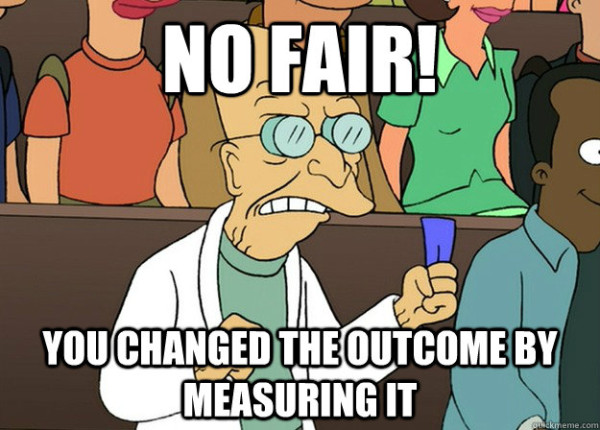As we go further and further down into the world of infinitesimally small physics the rules we use at the macro level start to break down. Where once we had defined rules that governed the behaviour of bodies interacting with each other we quickly end up in the realm of possibilities rather than definites, something which causes no end of grief to those seeking to understand it. Indeed whenever I feel like I’m getting close to understanding a fraction of what quantum mechanics is something else comes out of left field that ruins it, leaving me with a bunch of disjointed pieces of information that I try to make sense of yet again. Today I bring you one such piece which both makes complete sense yet is completely nonsensical Physicists at our very own Australian National University designed an experiment to test the wave/particle duality that single atoms can exhibit. Their experiment consisted of a stream of single helium atoms that were fired down an apparatus that contained 2 light gates which, if activated, would cause a interference pattern when measured (indicating a wave). However should only one of the gates be open then the particle would travel down a single path (indicating a particle). The secret sauce to their experiment was that the second gate, the one which would essentially force the particle to travel as a wave, was turn on randomly but only after the particle would have already traversed the gate. This essentially proves the theory that, when we’re operating at the quantum level, nothing is certain until measurements are made.
Physicists at our very own Australian National University designed an experiment to test the wave/particle duality that single atoms can exhibit. Their experiment consisted of a stream of single helium atoms that were fired down an apparatus that contained 2 light gates which, if activated, would cause a interference pattern when measured (indicating a wave). However should only one of the gates be open then the particle would travel down a single path (indicating a particle). The secret sauce to their experiment was that the second gate, the one which would essentially force the particle to travel as a wave, was turn on randomly but only after the particle would have already traversed the gate. This essentially proves the theory that, when we’re operating at the quantum level, nothing is certain until measurements are made.
Extrapolating from this you can make some pretty wild theories about the mechanism of action here although there are only a few that can truly make sense. My favourite (and the one that’s least likely to be real) is that the information about the gate activation travelled back in time and informed the particle of the state before it traversed them, meaning that it was inevitable for it to be measured that way. Of course the idea of information travelling back in time violates a whole slew of other physical laws but if that proved to be correct the kind of science we could pursue from it would be straight out of science fiction. I know that’s not going to happen but there’s a part of me that wants to believe.
The far more mundane (and more likely) explanation for this phenomena is that the atom exists as both a particle and a wave simultaneously until it is observed at which point it collapses down into the only possibility that make sense. Whilst some may then extend this to mean things like “The world doesn’t exist unless you’re looking at it” it’s actually a far more nuanced problem, one that requires us to understand what constitutes measurement at a quantum level. At a fundamental level most of the issues arise out of the measurement altering the thing you’re trying to observe although I’m sure there’s far more to it than that.
I’m honestly not sure where these results will take us as whilst it provides evidence for one interpretation of quantum mechanics I don’t know where the future research might be focused. Such an effect doesn’t appear to be something we can make use of, given the fact that measurement needs to take place for it to (in essence) actually happen, but I’ll be the first to admit that my knowledge of this area is woefully limited.
Perhaps I should take a wander down to the university, although I fear I’d only walk out of there more confused than ever…


